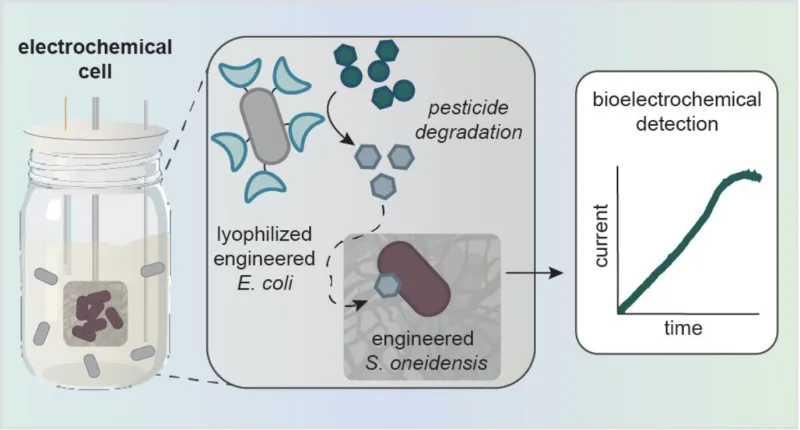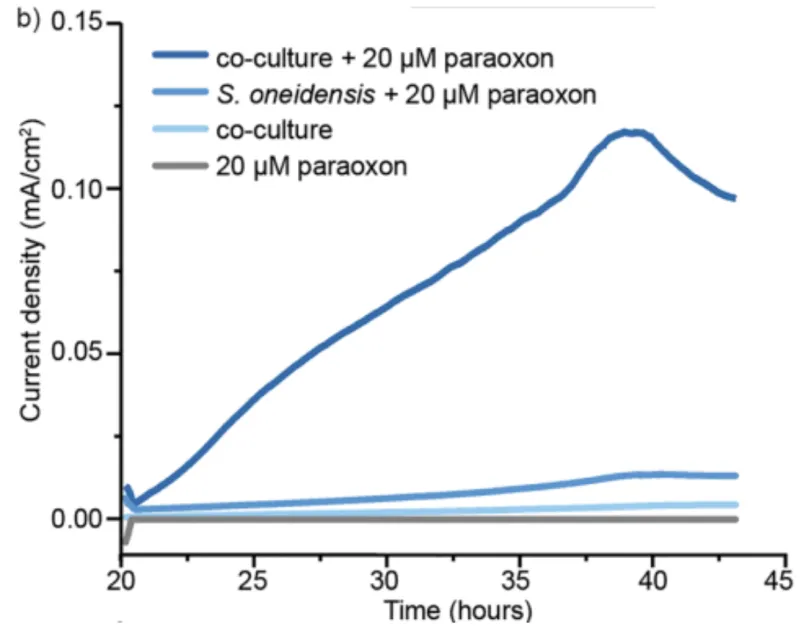A Microbial Electrochemical Technology to Detect and Degrade Organophosphate Pesticides
This technology aims to detect and dismantle organophosphate (OP) pesticides such as parathion and paraoxon by utilizing engineered microbial co-cultures of E. coli and S. oneidensis. Its primary application is in agriculture, serving as a defense against health risks associated with pesticide exposure. Furthermore, it holds potential for addressing various other harmful environmental pollutants.
Researchers
-
a microbial electrochemical technology to detect and degrade organophosphate pesticides
United States of America | Published application
Figures
Technology
This technology works by degrading and detecting OPs through engineered microbes. First, engineered E. coli is used as a scaffold to express and display on its surface an organophosphate hydrolase (OPH), parathion hydrolase, which degrades OPs. Using E. coli as a platform to express the OPH allows for greater stability, bypassing the challenges of protein handling that arise with the use of OPHs on their own. The degradation of OPs yields a byproduct called p-nitrophenol (p-NP). In response to this byproduct, the second engineered microbe in the system, S. oneidensis, generates a current through the process of Extracellular Electron Transfer (EET). The S. oneidensis microbe is engineered to express a transcription factor called DmpR (dimethyl phenol regulator), which activates its promoter Pdmp in response to p-NP. The microbe is engineered such that Pdmp controls a periplasmic EET protein, CymA. This means that when DmpR activates Pdmp in response to p-NP, CymA is expressed. The expression of CymA completes the EET pathway, generating a measurable electrical current. Since this current is proportional to the amount of OP detected, OP levels can be quantitatively measured.
Problem Addressed
OPs, the most widely-used pesticides in industrialized countries, cause environmental contamination and pose a serious threat to human health following exposure. While there are already technologies available to either detect or degrade OPs, there is no current method to perform both functions in a single system as offered by this technology. A single system would simplify the remediation process, making it easier for farmers to remove OPs from their environment. This approach also offers microbial stability and viability in degrading OPs, as well as greater accuracy and specificity in detecting them.
Advantages
- Provides both detection and degradation of harmful OPs in a single assay or application
- Detects OP degradation products at the level of parts per million, providing more accurate
- measurements than those from absorbance and fluorescence sensors
- Detection is specific to p-NP, preventing false readouts due to the presence of off-target phenols in natural systems
- Increased storage life due to freeze-drying of E. coli cells
Publications
Amruta A. Karbelkar, Erin E. Reynolds, Rachel Ahlmark, and Ariel L. Furst. A Microbial Electrochemical Technology to Detect and Degrade Organophosphate Pesticides. ACS Cent Sci. 2021 Sept 21. doi: 10.1021/acscentsci.1c00931
License this technology
Interested in this technology? Connect with our experienced licensing team to initiate the process.
Sign up for technology updates
Sign up now to receive the latest updates on cutting-edge technologies and innovations.

